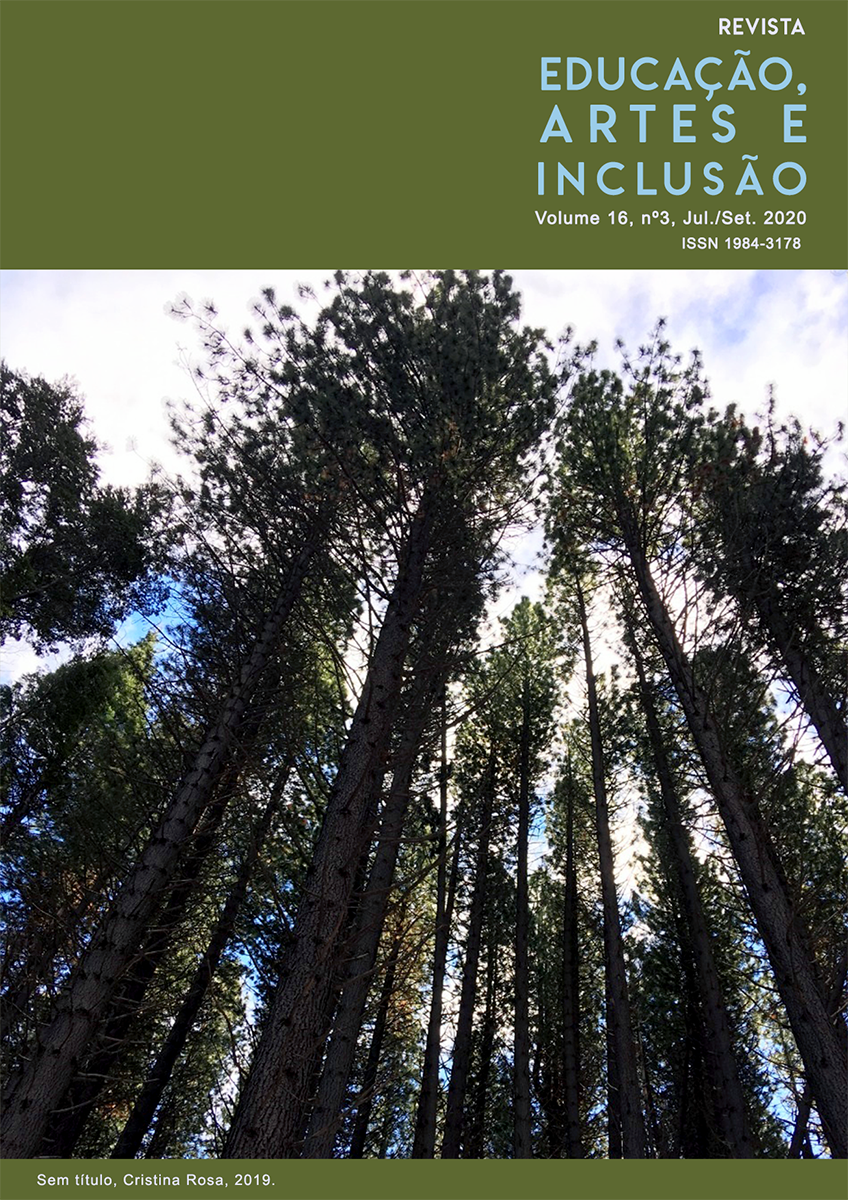Cross-Cultural Narrative through graphic stories In Polisario Refugee Camps
DOI:
https://doi.org/10.5965/198431781632020103Palavras-chave:
Visual Interaction, Graphic Storytelling, Saharawi Refugee CampsResumo
The Graphic Novel as a development of the last decades and nowadays an independent art form is presented in the context of workshop series within its educational potentials. Graphic story telling workshop series as methology exemplifies us an alternative form of communication beyond textual literacy. This took place within the framework of teacher training workshops in the Polisario refugee camps in Algeria. With the possibilities of the graphic novels, contents from the school environment and the everyday life of the participants were developed by means of art education, in the sense of a reflection of the own work event/ reference, for oneself and others. Drawings and personal stories from everyday life were developed in detail in the form of successive pictures and pictorial elements, sometimes including writing. In a non-verbal and playful way, the reality of life should come to face. In particular, one's own experiential space should be experienced as a source of creativity - personal, original, self-referential should be appreciated and valued. Unconventional forms of communication were generated and established as mutually effective educational methods.Downloads
Referências
ARENDT, Hannah. Macht und Gewalt. München: Piper, 1970.
EISNER, Will. Graphic Storytelling and Visual Narrative. 9th edition, Tamarac, 2004. Communicating about Graphic Novel – Series of Workshops. Universität Maribor, https://doaj.org/article/d54114147dd3407cb8bcc2cc45402c06. Acess Sept. 23, 2019.
FENNINGER, Erich and WEIDENHOLZER, Josef. Preface. In: FENNINGER, Erich. Von Freiheit träumen. Das Flüchtlingsleben der Westsahrauis. Wien: Mandelbaum, 2001.
GALEANO, Eduardo. Mauern – die Sahraouis dürsten nach Gerechtigkeit. 2006. http://www.oesg.ws/mediaarchiv/1/media/ Dokumente/Mauern_von_Eduardo_Galeano.pdf. Acess march, 20, 2020.
GALEANO, Eduardo. Walls. 2015. http://removethewall.org/walls-eduardo-galeano/ Acess march, 20, 2020.
HERRIGER, Norbert. Empowerment in der sozialen Arbeit. Eine Einführung. Stuttgart: Kohlhammer, 2014.
LAVEN, Rolf. Franz Čižek und die Wiener Jugendkunst. Wien: Schlebrügge, 2006.
MAROTZKI, K., W. and STOETZER, K. The Stories behind the Images (Die Geschichten hinter den Bildern. In: MAROTZK, K and NIESYTO, H. (eds.) Image interpretation and image understanding. Methodical approaches from a social science, art and media education perspective. (Bildinterpretation und Bildverstehen. Methodische Ansätze aus sozialwissenschaftlicher, kunst- und medienpädagogischer Perspektive). Wiesbaden: VS Verlag für Sozialwissenschaften, 2006.
MAYRING, Philipp. Introduction to qualitative social research (Einführung in die qualitative Sozialforschung). Weinheim: Basel, 2002, p. 50-54.
STRÖTER-BENDER, Jutta and WOLTER, Heidrun. The UNESCO World Heritage Site in art lessons. Materials for Primary Schools, Vol.1 (Das Weltkulturerbe der UNESCO im Kunstunterricht. Materialien für die Grundschule, Band 1). Donauwörth, 2005.
UNO RESOLUTION S/RES 2414 (2018) ADOPTED AT THE 8246TH SESSION OF THE SECURITY COUNCIL ON 27.04.2018
WELSCH, W. Use of terms in the sense of Wolfgang Welsch: Transculturality. In: KIRLOSKA-STEINBACH, Monika; DHARAMPAL-FRICK, Gita and FRIELE, Minou (org.): The interculturality debate - leading and controversial terms (Die Interkulturalitätsdebatte – Leit- und Streitbegriffe). Freiburg, 2012.
STAIGER, Michael. Pictures tell a story. On dealing with visual narrativity in German lessons (Bilder erzählen. Zum Umgang mit visueller Narrativität im Deutschunterricht). In: OOMEN-WELKE, Ingelore and STAIGER, Michael (publisher). Images in media, art, literature, language, didactics. Special Edition for Adalbert Wichert (Bilder in Medien, Kunst, Literatur, Sprache, Didaktik. Festschrift für Adalbert Wicher). Fillibach, p. 41-51, 2012.
UHLIG, Bettina. The narrative dimensions of the childlike image concept (Die narrativen Dimensionen des kindlichen Bildkonzepts). In: LIEBER, Gabriele and UHLIG, Bettina (org.). Narration: Transdisciplinary paths to art didactics in context of art education (Narration: Transdisziplinäre Wege zur Kunstdidaktik (Kontext Kunstpädagogik), München. p. 175-187, 2016.
Downloads
Publicado
Como Citar
Edição
Seção
Licença
A Revista Educação Artes e Inclusão é um periódico que segue a Política de Acesso Livre. Os artigos publicados pela revista são de uso gratuito, destinados a aplicações educacionais e não comerciais. Os artigos cujos autores são identificados representam a expressão do ponto de vista de seus autores e não a posição oficial da Revista Educação, Artes e Inclusão [REAI].
Autores que publicam nesta revista concordam com os seguintes termos:
(a) Autores mantém os direitos autorais e concedem à revista o direito de primeira publicação, com o trabalho simultaneamente licenciado sob a Licença Creative Commons Attribution que permite o compartilhamento do trabalho com reconhecimento da autoria e publicação inicial nesta revista.
(b) Autores têm autorização para assumir contratos adicionais separadamente, para distribuição não-exclusiva da versão do trabalho publicada nesta revista (ex.: publicar em repositório institucional ou como capítulo de livro), com reconhecimento de autoria e publicação inicial nesta revista.
(c) Esta revista proporciona acesso público a todo o seu conteúdo, uma vez que isso permite uma maior visibilidade e alcance dos artigos e resenhas publicados. Para maiores informações sobre esta abordagem, visite Public Knowledge Project.
Esta revista está licenciada com uma Licença Creative Commons Atribuição-NãoComercial 4.0 Internacional. Esta licença permite que outros remixem, adaptem e criem a partir do seu trabalho para fins não comerciais, e embora os novos trabalhos tenham de lhe atribuir o devido crédito e não possam ser usados para fins comerciais, os usuários não têm de licenciar esses trabalhos derivados sob os mesmos termos.





